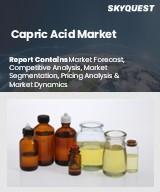
카프릭산 세계 시장 규모는 2023년에 1억 8,830만 달러, 2024년 2억 393만 달러에서 2032년에는 3억 8,593만 달러에 이르고, 예측 기간(2025-2032년) CAGR 8.3%의 성장이 예측됩니다.
카프릭산 시장은 다양한 용도와 코코넛 오일과 팜 커널 오일로부터의 지속 가능한 조달로 인해 성장세를 보이고 있습니다. 카프릭산은 퍼스널케어 산업에서 스킨케어 및 헤어케어 제품에서 피부 연화제 및 항균제로 사용되며, 식품 및 음료 산업에서 향료 및 방부제로 사용됩니다. 또한, 식품 및 음료 산업에서 향료 및 방부제로 사용되어 시장에서의 매력을 높이고 있습니다. 또한, 카프릭산은 에스테르, 윤활제, 가소제 생산에 새로운 역할을 하고 있으며, 이는 산업적 용도의 확장을 시사하고 있습니다. 규제 당국의 지원과 R&D 투자 증가는 카프릭산의 수용성을 더욱 높이고 있습니다. 아시아태평양은 자원의 가용성으로 인해 성장을 주도하고 있으며, 북미와 유럽은 기술 혁신에 중점을 두어 카프릭산을 지속적인 시장 개척에 배치하고 있습니다.
Global Capric Acid Market size was valued at USD 188.3 million in 2023 and is poised to grow from USD 203.93 million in 2024 to USD 385.93 million by 2032, growing at a CAGR of 8.3% during the forecast period (2025-2032).
The capric acid market is gaining momentum, driven by its versatility and sustainable sourcing from coconut and palm kernel oils. Its applications span the personal care industry, where it is valued for its emollient and antimicrobial properties in skincare and haircare products. The pharmaceutical sector is exploring capric acid for potential treatments against bacterial and fungal infections, while the food and beverage industry utilizes it as a flavoring agent and preservative, enhancing its market appeal. Additionally, capric acid's emerging role in the production of esters, lubricants, and plasticizers signals expansion in industrial applications. Regulatory support and increasing R&D investments further bolster its acceptance. The Asia-Pacific region leads growth due to resource availability, with North America and Europe focusing on innovation, positioning capric acid for sustained market development.
Top-down and bottom-up approaches were used to estimate and validate the size of the Global Capric Acid market and to estimate the size of various other dependent submarkets. The research methodology used to estimate the market size includes the following details: The key players in the market were identified through secondary research, and their market shares in the respective regions were determined through primary and secondary research. This entire procedure includes the study of the annual and financial reports of the top market players and extensive interviews for key insights from industry leaders such as CEOs, VPs, directors, and marketing executives. All percentage shares split, and breakdowns were determined using secondary sources and verified through Primary sources. All possible parameters that affect the markets covered in this research study have been accounted for, viewed in extensive detail, verified through primary research, and analyzed to get the final quantitative and qualitative data.
Global Capric Acid Market Segments Analysis
Global Capric Acid Market is segmented by Grade, Purity, Application, End Use Industry and region. Based on Grade, the market is segmented into Technical Grade, Pharmaceutical Grade and Food Grade. Based on Purity, the market is segmented into >99%, 97-99% and 95-97%. Based on Application, the market is segmented into Food and Beverages, Pharmaceuticals, Personal Care and Industrial. Based on End Use Industry, the market is segmented into Food Processing, Pharmaceutical Manufacturing, Cosmetics and Personal Care and Chemical Manufacturing. Based on region, the market is segmented into North America, Europe, Asia Pacific, Latin America and Middle East & Africa.
Driver of the Global Capric Acid Market
The increasing consumer inclination towards natural and organic products is significantly driving the global capric acid market. Sourced mainly from coconut and palm kernel oils, capric acid is favored for its inherent properties, making it a sought-after ingredient across various sectors, including cosmetics, personal care, and food & beverages. In 2024, numerous beauty and skincare brands have emphasized capric acid for its moisturizing, antibacterial, and soothing qualities; for instance, Cocoon Apothecary incorporates it into their formulations to leverage its natural effectiveness. Additionally, capric acid's antimicrobial properties are elevating its role in food preservation, particularly within the realm of organic and natural food items, thus amplifying demand in this area.
Restraints in the Global Capric Acid Market
The global capric acid market faces significant constraints primarily due to the fluctuating prices of its raw materials, namely coconut oil and palm kernel oil. These price variations are influenced by numerous factors, including adverse weather conditions, crop yields, and global supply chain issues. In 2024, the market experienced notable volatility as climate change adversely affected palm and coconut plantations, particularly in Southeast Asia. This instability not only drove up the cost of capric acid but also posed considerable challenges for producers, particularly small and medium-sized enterprises (SMEs), that struggle with sourcing raw materials amid these rising prices.
Market Trends of the Global Capric Acid Market
In 2024, the Global Capric Acid market is witnessing a pronounced shift towards sustainability and green chemistry, which is reshaping production practices and consumer preferences. Manufacturers are increasingly prioritizing eco-friendly processes that focus on reducing carbon emissions, leveraging renewable resources, and minimizing waste. This trend is driven by mounting consumer demand for environmentally conscious products. Prominent companies, such as IOI Oleochemicals, are setting benchmarks by committing to sustainable sourcing, including the use of RSPO-certified palm oil. This alignment with environmental sustainability not only meets regulatory requirements but also caters to a growing consumer base that values ecological responsibility in their purchasing decisions, thus enhancing market growth.